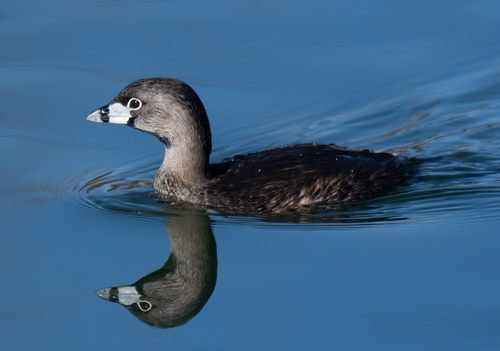
Pied-billed Grebe
The Pied-billed Grebe (Podilymbus podiceps) is a small, stocky waterbird known for its distinctive bill markings and remarkable diving abilities. It plays a crucial role in freshwater ecosystems as both predator and prey, consuming a variety of aquatic invertebrates and small fish, while also serving as a food source for larger predators like raptors and snapping turtles. Unlike many other grebe species, the Pied-billed Grebe is not known for elaborate courtship displays, focusing instead on efficient nest building and chick rearing. It is widely distributed across the Americas and is a common sight in ponds, lakes, and marshes.
31-38 cm
Length
45-62 cm
Wingspan
Least Concern
Conservation Status
Distribution
The Pied-billed Grebe is found throughout North, Central, and South America, as well as the Caribbean. Its range extends from southern Canada to southern South America. It is primarily a migratory bird in the northern parts of its range, moving south for the winter. Altitudinal range extends from sea level to high-altitude lakes in some regions.
Lifespan
The average lifespan in the wild is not well documented, but is estimated to be between 5-10 years. Captive birds have been known to live longer.
Pied-billed Grebe's Habitat
Habitat Types
Freshwater marshes, Ponds, Lakes, Slow-moving rivers, Coastal wetlands (during migration and winter)
Climate Zones
Temperate, Subtropical, Tropical
Adaptations
Pied-billed Grebes have lobed toes, which provide excellent propulsion underwater. They can also adjust their buoyancy, allowing them to sink slowly and silently below the surface to ambush prey or escape predators. Their dense, waterproof plumage provides insulation in cold water.
Variations
There are three recognized subspecies: *Podilymbus podiceps podiceps* (most of North America), *Podilymbus podiceps antillarum* (Caribbean), and *Podilymbus podiceps antarcticus* (South America). These subspecies show slight variations in size and plumage coloration.
Appearance
Breeding Plumage
Breeding plumage features a black band around the bill (hence 'pied-billed') and a black throat patch. Non-breeding plumage is duller, lacking the black band and throat patch, and is more brownish overall.
Seasonal Feather Changes
The change between breeding and non-breeding plumage occurs gradually through molting.
Sex Based Plumage Differences
Sexual dimorphism in plumage is minimal, with males and females having similar appearances, although males may have slightly bolder markings during the breeding season.
Notable Features
Thick, chicken-like bill with a black band in breeding plumage, Lobed toes (not webbed), Brownish body plumage, Short, rounded wings, Almost tailless appearance
Diet and Feeding
Primary Foods
Aquatic insects, Crustaceans, Small fish, Amphibians, Leeches
Foraging Behavior
Pied-billed Grebes are expert divers, typically foraging underwater. They propel themselves with their feet and can stay submerged for up to 30 seconds. They may also glean insects from vegetation at the water's surface.
Specializations
Their bill shape is well-suited for capturing a variety of prey, from small insects to larger fish. They can also consume their own feathers, which are thought to help protect their digestive tract from sharp fish bones and aid in pellet formation (regurgitated indigestible material).
Seasonal Diet Variations
Diet can vary seasonally depending on prey availability. During the breeding season, they may consume more insects, while in winter, they may rely more on fish and crustaceans.
Behavior
Social Structure
Pied-billed Grebes are generally solitary or found in pairs during the breeding season. Outside of the breeding season, they may form small, loose flocks, particularly during migration or on wintering grounds.
Communication
A variety of calls, including a loud, cackling 'kow-kow-kow' series, Whistles, Chatters, Bill snaps (during aggressive encounters)
Migration
Northern populations are migratory, moving south to ice-free waters for the winter. Southern populations may be resident or undertake shorter, local movements.
Territorial or Group Behaviors
During the breeding season, Pied-billed Grebes are highly territorial, defending their nesting area from other grebes and potential predators. They are known for their aggressive defense, often diving and attacking intruders from below.
Conservation
Threats
Habitat loss and degradation (wetland drainage), Water pollution (pesticides, heavy metals), Collisions with human-made structures (e.g., power lines), Disturbance from human activities (e.g., boating), Climate change (altering wetland habitats)
Protection Programs
Wetland conservation and restoration efforts, Migratory Bird Treaty Act (in the United States), Various state and provincial wildlife regulations
Local National Laws
Protected under the Migratory Bird Treaty Act in the United States, Canada, and Mexico. Specific regulations may vary by state or province.
Population Trend
Stable
Population Estimates
The global population is estimated to be between 370,000 and 1,200,000 individuals.
Interesting Facts
They can sink slowly and silently below the water's surface.
This is achieved by compressing their plumage and expelling air from their body, allowing them to control their buoyancy.
They often eat their own feathers.
This behavior is thought to help protect their stomach lining from sharp fish bones and to form pellets of indigestible material that they can regurgitate.
Chicks often ride on their parents' backs.
This provides protection from predators and helps the chicks conserve energy.
Known to nest in loose colonies in areas with abundant resources
Typically solitary breeders, the availability of food and nesting materials can result in clusters of nests.
Faqs about Pied-billed Grebe
What is the difference between a Pied-billed Grebe and a duck?
Pied-billed Grebes have lobed toes, not webbed feet like ducks. They also have a more pointed bill and a much smaller tail. Grebes are also more specialized for diving.
Why is it called 'Pied-billed'?
The name refers to the black band around the bill that appears during the breeding season. 'Pied' means having two or more colors.
Where can I see a Pied-billed Grebe?
Look for them in freshwater marshes, ponds, and lakes with emergent vegetation. They are widespread across North and South America.
Are Pied-billed Grebes endangered?
No, they are classified as 'Least Concern' by the IUCN, meaning they have a stable population.
Do Pied-billed Grebes fly much?
While capable of flight, they are more often seen swimming and diving. Northern populations migrate, requiring significant flight, but they often prefer to escape danger by diving rather than flying.
Copyright @ Nature Style Limited. All Rights Reserved.
 English
English